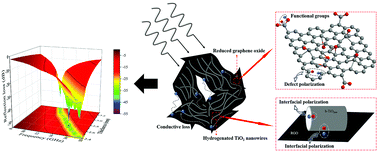Enhanced microwave absorption properties of reduced graphene oxide/TiO2 nanowire composites synthesized via simultaneous carbonation and hydrogenation†
Abstract
High-performance microwave absorbing materials of reduced graphene oxide (RGO) combined with hydrogenated TiO2 nanowires (h-TiO2nw) were prepared via a solvothermal and annealing method, in which carbonation and hydrogenation processes were achieved simultaneously. The incorporation of h-TiO2nw not only strengthened the interfacial polarization by introducing a large number of interfaces with RGO, but also made great contributions to the impedance matching of RGO/h-TiO2nw composites with air. By adjusting the weight content of h-TiO2nw, the complex permittivity of the composites could be well-controlled and an excellent microwave absorption performance was realized. For the absorber/paraffin mixture with an ultralow filler content (2 wt%), a minimum reflection loss value of −51.5 dB at 15.1 GHz and a broad effective absorption bandwidth of 6.46 GHz were achieved under the same small thickness of 2.7 mm. Such performance exhibits great advantages compared to most graphene-based materials in the literature. These results demonstrate that such RGO/h-TiO2nw composites can be potential candidates for lightweight, broadband, and strong microwave absorption materials.



 Please wait while we load your content...
Please wait while we load your content...